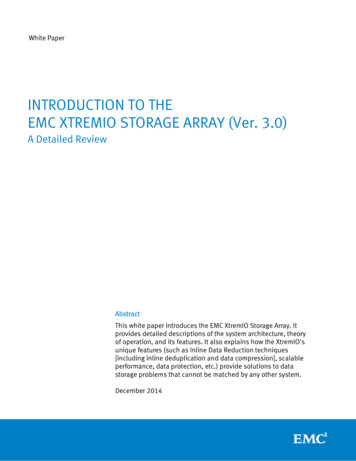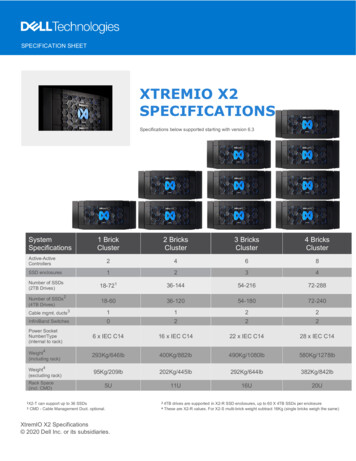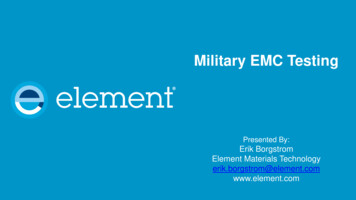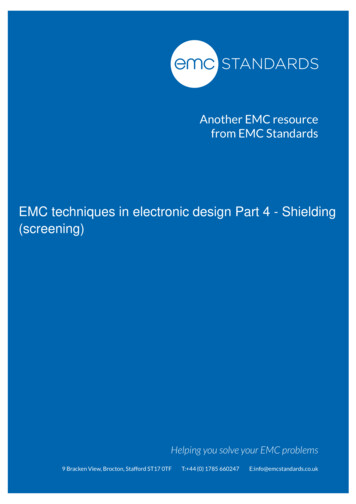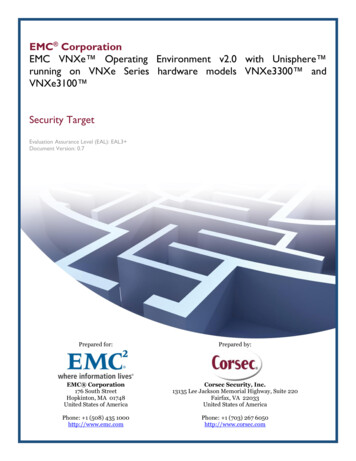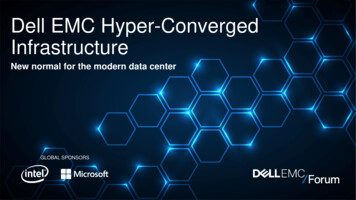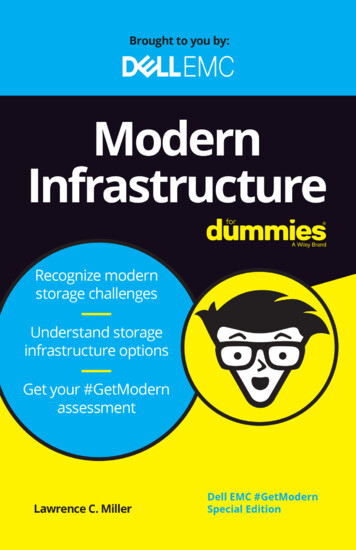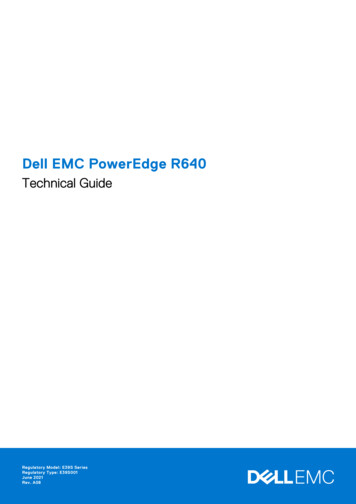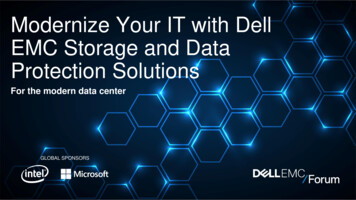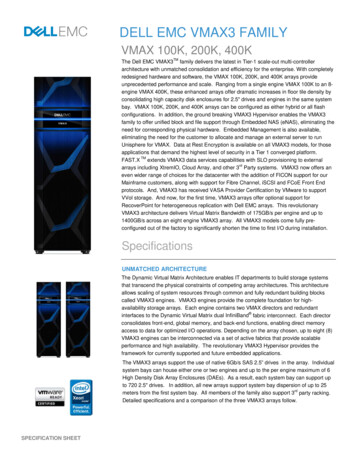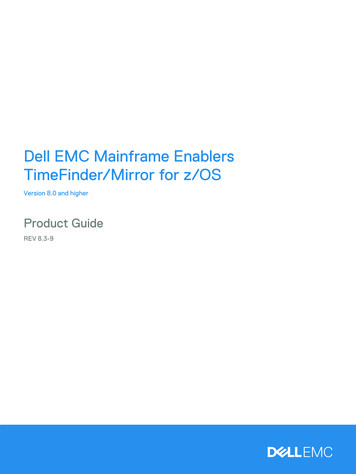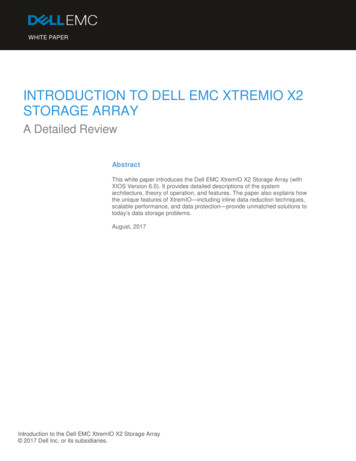
Transcription
WHITE PAPERINTRODUCTION TO DELL EMC XTREMIO X2STORAGE ARRAYA Detailed ReviewAbstractThis white paper introduces the Dell EMC XtremIO X2 Storage Array (withXIOS Version 6.0). It provides detailed descriptions of the systemarchitecture, theory of operation, and features. The paper also explains howthe unique features of XtremIO—including inline data reduction techniques,scalable performance, and data protection—provide unmatched solutions totoday’s data storage problems.August, 2017Introduction to the Dell EMC XtremIO X2 Storage Array 2017 Dell Inc. or its subsidiaries.
ContentsAbstract . 1Executive Summary. 4Introduction. 4System Overview. 5X-Brick . 6Scale-Out Architecture: Linear Expansion of Capacity and Performance . 6Scale-Up Architecture: Capacity Expansion. 8System Architecture . 9Theory of Operation. 10XtremIO Metadata . 10Mapping Table. 11How the Write I/O Flow Works . 11How the Read I/O Flow Works . 15System Features . 16Inline Data Reduction . 16Inline Data Deduplication . 16Inline Data Compression . 17Total Data Reduction . 18Integrated Copy Data Management (iCDM) . 18XtremIO Virtual Copies (Snapshots) . 20Thin Provisioning . 22XtremIO Data Protection (XDP) . 23How XDP Works. 24Data at Rest Encryption . 25Scalable Performance . 26Even Data Distribution . 28High Availability . 29Non-Disruptive Upgrade and Expansion . 30VMware VAAI Integration . 31XtremIO Management Server (XMS) . 34System GUI . 35Command Line Interface . 36RESTful API . 36PowerShell API . 36LDAP/LDAPS . 37Ease of Management . 372 Introduction to the Dell EMC XtremIO X2 Storage Array 2017 Dell Inc. or its subsidiaries.
Replication of Dell EMC XtremIO to a Remote Array . 37Dell EMC RecoverPoint . 37Solutions Brief . 38Dell EMC RecoverPoint Replication for XtremIO . 38Synchronous and CDP Replication for XtremIO . 40Integration with other Dell EMC Products . 41System Integration Solutions . 42Dell EMC VxBlock . 42Dell EMC VSPEX . 42Management and Monitoring Solutions . 42Dell EMC Storage Analytics (ESA) . 42Dell EMC Storage Integrator (ESI) Plugin for Windows . 42Dell EMC Storage Integrator (ESI) Plugin for Oracle VM . 43Dell EMC ViPR Controller . 43Dell EMC ViPR SRM . 43Virtual Storage Integrator (VSI) Plugin for VMware vCenter . 44Application Integration Solutions . 44Dell EMC AppSync . 44Oracle Enterprise Manager (OEM) Plugin . 44Business Continuity and High Availability solutions . 45Dell EMC PowerPath . 45Dell EMC VPLEX. 45OpenStack Integration . 45Conclusion. 463 Introduction to the Dell EMC XtremIO X2 Storage Array 2017 Dell Inc. or its subsidiaries.
Executive SummaryDell EMC XtremIO's 100% flash-based scale-out enterprise storage array delivers not only high levels of performance andscalability, but also brings new levels of ease-of-use to SAN storage, while offering advanced features that have neverbeen possible before.XtremIO's ground-up all-flash array design was created from the start for maximum performance and consistent lowlatency response times, and with enterprise grade high availability features, real-time Inline Data Reduction thatdramatically lowers costs, and advanced functions such as thin provisioning, tight integration to VMware, copy, volumecopies, and very efficient data protection.The product architecture addresses all requirements for flash-based storage, including achieving longevity of the flashmedia, lowering the effective cost of flash capacity, delivering performance and scalability, providing operationalefficiency, and delivering advanced storage array functionality.This white paper provides a broad introduction to the Dell EMC XtremIO X2 Storage Array, with detailed descriptions ofthe system architecture, theory of operation, and its various features.IntroductionXtremIO is an all-flash storage array that has been designed from the ground-up to unlock flash's full performancepotential by uniquely leveraging characteristics of SSDs, based on flash media.XtremIO uses industry-standard components and proprietary intelligent software to deliver unparalleled levels ofperformance. Achievable performance ranges from hundreds of thousands to millions of IOPS, and consistent low latencyof under one millisecond. 1The system is also designed with simplicity, providing a user-friendly interface that makes provisioning and managing thearray very easy. The system can be provisioned with minimal planning.XtremIO leverages flash to deliver value across the following main dimensions: PerformanceRegardless of the system load, written capacity and workload characteristics, latency, and throughput remainconsistently predictable and constant. Latency within the array for an I/O request is typically far less than onemillisecond.* ScalabilityThe XtremIO storage can be expanded for only capacity (scale-up) or both capacity and performance (scale-out).The system begins with a single building block, called an X-Brick with a minimum of 18 SSDs. When additionalcapacity is required, the system scales up, with up to 72 SSDs for a single X-Brick. When additional performanceand capacity is required, the system can be expanded by adding additional X-Bricks.Performance scales linearly, ensuring that two X-Bricks can deliver twice the IOPS of a single X-Brickconfiguration, three X-Bricks deliver three times the IOPS, four X-Bricks deliver four times the IOPS, and so on.Latency remains consistently low as the system scales out.1As measured for small block sizes. Large block I/O by nature incurs higher latency on any storage system.4 Introduction to the Dell EMC XtremIO X2 Storage Array 2017 Dell Inc. or its subsidiaries.
EfficiencyThe core engine implements content-based Inline Data Reduction. The XtremIO X2 Storage Array automaticallyreduces (deduplicates and compresses) data on the fly, as it enters the system. This reduces the amount of datawritten to flash, improving longevity of the media and driving down cost. XtremIO arrays allocate capacity tovolumes on-demand in granular data blocks. Volumes are always thin-provisioned without any loss ofperformance, over-provisioning of capacity, or fragmentation. Once content-based inline deduplication isimplemented, the remaining data is compressed even further, reducing the number of writes to the flash media.The data compression is carried out inline on the deduplicated (unique) data blocks. oBenefits gained from avoiding a large percentage of writes include:oBetter performance due to reduced dataoIncreased overall endurance of the flash array's SSDsoLess required physical capacity to store the data, increasing the storage array's efficiency anddramatically reducing the /GB cost of storageData ProtectionXtremIO leverages a proprietary flash-optimized data protection algorithm (XtremIO Data Protection or XDP),which provides performance that is superior to any existing RAID algorithm. Optimizations in XDP also result infewer writes to flash media for data protection purposes. Integrated Copy Data ManagementXtremIO allows consolidation of many different workloads and copies of those workloads (for example, test anddevelopment) on one array. You can create a larger number of high performance and space-efficient copies usingXtremIO Virtual Copies (XVC) or using highly efficient XCOPY using VMware VAAI integration.System OverviewThe XtremIO X2 Storage Array is an all-flash system, based on flexible scaling options. The system uses building blockscalled X-Bricks, which can be clustered together to grow performance or capacity, or both, as required.System operation is controlled via a stand-alone dedicated Linux-based server called the XtremIO Management Server(XMS). An XMS host, which can be either a physical or a virtual server, can manage multiple XtremIO clusters. An arraycontinues operating if it is disconnected from the XMS, but cannot be configured or monitored.XtremIO architecture is based on a metadata-centric, content-aware system. The metadata-centric model helps tostreamline data operations efficiently without requiring any movement of data. The system is content-aware where thedata is laid out uniformly across all SSDs using the unique fingerprint of the incoming data.This means that the architecture is specifically designed to deliver the full performance potential of flash, while linearlyscaling and utilizing all resources such as CPU, RAM, SSDs, and host ports in a balanced manner. This allows the arrayto achieve any desired performance level, while maintaining consistency of performance that is critical to predictableapplication behavior.The XtremIO Storage System provides a very high level of performance that is consistent over time, system conditionsand access patterns. It is designed for true random I/O.The system's performance level is not affected by its capacity utilization level, number of volumes, or aging effects.Moreover, performance is not based on a "shared cache" architecture and therefore it is not affected by the dataset sizeor data access pattern.Due to its content-aware storage architecture, XtremIO provides: Even distribution of data blocks between the available SSDs, inherently leading to maximum performance andminimal flash wear Even distribution of metadata between the available SSDs5 Introduction to the Dell EMC XtremIO X2 Storage Array 2017 Dell Inc. or its subsidiaries.
No data or metadata hotspots Easy setup and no tuning Advanced storage functionality, including Inline Data Reduction (deduplication and data compression), thinprovisioning, advanced data protection (XDP), Snapshots, and moreX-BrickFigure 1 shows an X-Brick.1USecondStorage Controller1UFirstStorage Controller2UDAE4UFigure 1.X-BrickAn X-Brick is the basic building block of an XtremIO array. There are two X-Brick types available: X2-S and X2-R.Systems using either type of X-Bricks can be used for any workload based on the workload's characteristics, capacity,and performance requirement. For example, if a deployment requires hundreds of terabytes of usable capacity, then X2-Ris a better choice because each X2-R X-Brick can scale up to over 100 TB of usable capacity. If a workload is I/Ointensive, contains more duplicated data, and hence a smaller capacity footprint, X2-S might be a better fit.Customers must decide in advance which option is better for their deployment. The two X-Brick types cannot be mixed ina single cluster/system, and there is no way to transform an X-Brick from one type to the other.Each X-Brick is comprised of: One 2U Disk Array Enclosure (DAE), containing:oUp to 72 SSDsoTwo redundant power supply units (PSUs)oTwo redundant SAS interconnect modulesTwo 1U Storage Controllers (redundant storage processors)Each Storage Controller includes:oTwo redundant power supply units (PSUs)oTwo 1/10GbE iSCSI portsoTwo user interface interchangeable ports, either 4/8/16Gb FC or 1/10GbE iSCSIoTwo 56Gb/s InfiniBand portsoOne 100/1000/10000 Mb/s management portScale-Out Architecture: Linear Expansion of Capacity and PerformanceAn XtremIO storage system can include a single X-Brick or multiple X-Bricks, as shown in Figure 2.6 Introduction to the Dell EMC XtremIO X2 Storage Array 2017 Dell Inc. or its subsidiaries.
Four X-BrickClusterThree X-BrickClusterTwo X-BrickClusterSingle X-BrickClusterFigure 2.System Configurations as Single and Multiple X-Brick ClustersNote: X2-S and X2-R can have up to four X-Bricks. In the future, X2-R will support up to eight X-Bricks.With clusters of two or more X-Bricks, XtremIO uses a redundant 56Gb/s (4xFDR) InfiniBand network for back-endconnectivity between the Storage Controllers, ensuring a highly available, ultra-low latency network.Multiple X-Brick clusters include two InfiniBand Switches. A single X-Brick cluster does not require any InfiniBandswitches.Table 1.InfiniBand Switches TypesX2-SX2-RFootprint1U1UPort Count1236Support
This white paper introduces the Dell EMC XtremIO X2 Storage Array (with XIOS Version 6.0). It provides detailed descriptions of the system architecture, theory of operation, and features. The paper also explains how the unique featur
